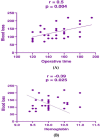Effect of bilateral uterine artery ligation on blood loss during total laparoscopic hysterectomy
- PMID: 40385587
- PMCID: PMC12083771
- DOI: 10.3389/fmed.2025.1577904
Effect of bilateral uterine artery ligation on blood loss during total laparoscopic hysterectomy
Abstract
Background: Hysterectomy is a common major gynecological surgery. Total laparoscopic hysterectomy (TLH) has become a preferred method over traditional approaches due to its minimally invasive nature and reduced postoperative complications.
Aim: This study aimed to compare conventional total laparoscopic hysterectomy (CTLH) with TLH involving bilateral uterine artery ligation (BUAL) at its origin, specifically evaluating blood loss and perioperative outcomes.
Methods: In this prospective randomized study conducted at Cairo University Hospital, 60 female patients undergoing TLH for benign uterine conditions were randomized. Group 1 (BUAL) involved bilateral uterine artery ligation at its origin, and Group 2 (CTLH) followed conventional TLH techniques. Preoperative assessments included comprehensive history, physical examinations, and relevant laboratory tests. Outcomes measured were intraoperative blood loss, operative time (from insufflation to skin suturing), intraoperative and postoperative complications, postoperative analgesic needs, and hospital stay.
Results: Both groups were demographically similar. The BUAL group experienced significantly lower blood loss (103.7 ± 23.27 mL) compared to the CTLH group (128.7 ± 42.57 mL) (p < 0.05). However, the mean operative time was slightly longer in the BUAL group (169.33 ± 15.85 min) than in the CTLH group (160.50 ± 19.75 min). No major surgical complications or blood transfusions were reported in either group. The posterior approach to uterine artery ligation in the BUAL group was more time-efficient.
Conclusion: Securing the uterine arteries at their origin during TLH reduces blood loss and provides a feasible alternative to conventional methods, despite a slightly longer operative time. Enhanced surgical expertise correlates with reduced operative duration and improved outcomes.
Keywords: blood loss; operative time; postoperative recovery; surgical complications; total laparoscopic hysterectomy; uterine artery ligation.
Copyright © 2025 El-Minawi, El-shenoufy, Hussein, El-fazary, Bahaa, Alsharif, AlRasheed and Eldardiry.
Conflict of interest statement
The authors declare that the research was conducted in the absence of any commercial or financial relationships that could be construed as a potential conflict of interest.
Figures
Similar articles
-
Uterine artery ligation at the beginning of total laparoscopic hysterectomy reduces total blood loss and operation duration.J Obstet Gynaecol. 2015;35(6):612-5. doi: 10.3109/01443615.2014.990431. Epub 2014 Dec 17. J Obstet Gynaecol. 2015. PMID: 25517762
-
Uterine artery closure at the origin vs at the uterus level in total laparoscopic hysterectomy: A randomized controlled trial.Acta Obstet Gynecol Scand. 2021 Oct;100(10):1840-1848. doi: 10.1111/aogs.14238. Epub 2021 Aug 15. Acta Obstet Gynecol Scand. 2021. PMID: 34396512 Clinical Trial.
-
An analysis of the impact of previous laparoscopic hysterectomy experience on the learning curve for robotic hysterectomy.J Robot Surg. 2013 Sep;7(3):295-9. doi: 10.1007/s11701-012-0388-6. Epub 2013 Feb 27. J Robot Surg. 2013. PMID: 27000926
-
Lateral closure of the uterine artery prior to laparoscopic hysterectomy: a systematic review.J Obstet Gynaecol. 2022 Jul;42(5):785-792. doi: 10.1080/01443615.2021.1968810. Epub 2021 Oct 23. J Obstet Gynaecol. 2022. PMID: 34689681
-
Perioperative Interventions to Minimize Blood Loss at the Time of Hysterectomy for Uterine Leiomyomas: A Systematic Review and Meta-analysis.J Minim Invasive Gynecol. 2019 Nov-Dec;26(7):1234-1252.e1. doi: 10.1016/j.jmig.2019.04.021. Epub 2019 Apr 27. J Minim Invasive Gynecol. 2019. PMID: 31039407
References
-
- Sandhu K, Wilson R, Yao M, Hackett L, Orlando M, Kho R. Racial and ethnic disparities in rates of minimally invasive hysterectomy across the United States: a systematic review. Am J Obstet Gynecol. (2024) 230:S1224–5. doi: 10.1016/j.ajog.2024.02.129 - DOI
-
- Jain V, Jain N. Laparoscopic port placement for TLH In: Complex Total laparoscopic hysterectomy (TLH) with newer approaches in bladder dissection. Springer Nature Singapore: Springer; (2024). 27–41.
-
- Drymiotou S, Dokmeci M, Chandrasekaran D, Jeyarajah A, Brockbank E. Impact of minimally invasive surgery on surgical outcomes for obese women with endometrial cancer following robotic surgery introduction; a single Centre study. Int J Med Robot Comput Assisted Surg. (2024) 20:e2559. doi: 10.1002/rcs.2559, PMID: - DOI - PubMed
LinkOut - more resources
Full Text Sources



